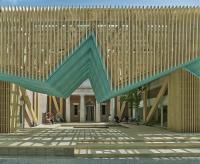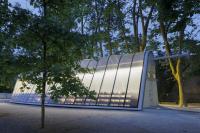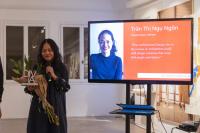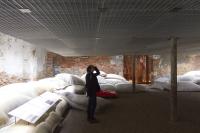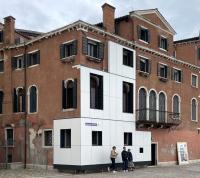CMPR. Central Mosque of Pristina
International open competition, 3rd Prize, 2013
The new Central Mosque has been intended to be one of the most important landmark-buildings not only for its immediate neighborhood but more important for entire Prishtina and the Muslim community of Kosovo. With the demanded mixed-use space program the mosque will be both: a major religious center as well as an important cultural and commercial institution of, its neighborhood, the city and the region as a whole. Thus the new central mosque needs to be both contextual and iconic on all scales. It needs to appear as a forward-looking icon as it has to show its roots to a very specific local and cultural context.
Therefore we have based our design for the Central Mosque on two cornerstones: on the one side we have done careful analyses of, local, Ottoman and Arab mosque-typologies and secondly we have gained an in-depth understanding of this specific site’s contextual needs and potentials.
Generally the context presents itself with fairly heterogeneous architectural structures. Next to that a significant height difference of around 18m in East-West direction shows great potential for a succesful urban integration of the demanded mixed-use program. As a first response to the topography we have used a simple, yet efficient section diagram: a mixed-use plinth formulates the, formal, functional, and structural, basis for the mosque-building at the top. This plinth contains, the carpark, the commercial and cultural center, and performs as the programmatic and structural basis for the mosque. The mosque itself is placed on top of the plinth as a strong and freestanding object with enough circumjacent space to take effect.
This layout allows for a spatially attractive separation of the demanded program as well as for an efficient separation of car- and pedestrian access. For the carpark we propose a fairly simple, economically interesting and spatially rich concept: diagonal visual interconnections, which are introduced through a split-level layout, create a feeling of grandeur and transform the parking area into a secondary lobby for the building’s visitors. Next to that we have limited excavation and foundation costs by locating approximately a third of the parking lots next to the competition site underneath what we have called the “green square”.
In floorplan the new Central Mosque is organized in a pentagon shape that shows several advantages in this case: it allows for maximized internal praying space, a clearly expressed Qibla-wall and – on its opposite site – two very large entrance facades separating the entrances of men and women in a self-evident manner. The sideways extensions of the center pentagon furthermore allow for the introduction of generous portico-wings that invite and shelter visitors. Especially these locally inspired porticos play an important role in the ordering of external yards – which again derive from typical mosque courtyards. In between the portico-wings lavish open spaces extend the portico’s program to the exterior. The resulting spatial sequences appear as carefully composed transitions from the bustling surroundings through spaces of increasing concentration towards the grandeur of the prayer hall.
For the prayer hall’s architectural concept we have developed a system of aggregated vaults that draw their inspiration from the great heritage of so called “muqarnas”-geometry. The result is a blend of the local portico-type with a hypostile-like transition into the great stalactite vault of the prayer hall itself. It is an apparently complex, geometrical, structural, and, spatial system that in fact is rigorously developed out of comparatively simple interlocked developable surfaces.
The minaret is conceived as a slender vertical concrete shell that opens towards the boulevard with a slit. At its top it quotes the shape of a traditional Ottoman minaret translating both, the typical point and the (former) balcony-shape into one elegant inviting gesture.
At night the minaret’s vertical opening will be lit whereby amount and colour of light will change slowly and slightly over time, subtly indicating important moments during the evening – as reminiscence to the typical local clock towers.
As a whole the mosque appears as a well proportioned monumental mass that embraces its direct urban context with the inviting gestures of its portico-wings.
- Arquitectos
- one fine day. office for architectural design
- Cliente
- The Islamic Community of Republic of Kosovo
- Equipo
- Holger Hoffmann, Hans-Peter Nünning, Hajdin Dragusha, Eva Hagen




